HOW TO MAKE A MICRO QUARTER PIPE
Let's build a "Micro Quarter"! Which is a smaller than average sized quarter pipe. That and I just like to say the word micro quarter... kind of rolls off the tounge... micro quarter.
This quarter pipe is 2' tall by 4' wide. Because of it's small size, the quarter pipe is great for basements, garages and driveways.
As with all structures here on DIYskate, you can build it any size you want. But for the material list to be accurate you will need to follow the plans as listed below.
WHERE TO GET SUPPLIES
The wood and hardware can be found at most home improvement stores. Sometimes you can find the steel there as well, I know my local Home Depot carries the coping and threshold material.
If not, you can search the internet for steel fabricators or salvage steel. Personally, I've begun buying my steel from MetalsDepot.com because of their very quick shipping and good prices. I'm not affiliated with them in any way, I just like them and their product.
If this ramp is going to stay outside, it needs to be protected from the elements. A good place to start is with pressure treated lumber, paint and a tarp. You may want to invest in a composite material for the surface too. Such as Skate Lite or Ramp Armor.
Be extra careful when working with treated lumber though, the chemicals used to treat the wood contain a poisonous pesticide.
BUILD IT
Gather all your materials. Start with the 2x4's. Cut 11 pieces at 3'-10 1/2 in length (you will get 2 out of each 8' long 2x4). Set them aside. Below is a cut list referencing what else you will need and it's size.
PLYWOOD LAYOUT
Obviously you can make your quarter pipe any size you want. However, for this set of plans you will need to use the dimensions provided in order for the material list to be accurate.
Above you will find a plywood layout illustration, it depicts the sides and deck of the quarter pipe being cut from a single sheet of 3/4" plywood.

DRAWING THE TRANSITION
Theres a few different ways to do this, I'm going to explain it the way I do it. Grab an 8" long 2x4. On one end, drill a hole the diameter of a pencil (about 3/8").
Then measure from the hole you just drilled, out the distance of the transition radius. In this case, 5'-6. Place a screw there but don't go all the way through the 2x4 yet.

Take your 3/4" plywood and lay it on a fairly level surface. Grab another sheet of plywood, your 3/8" sheet should do, you might have to place some scrap wood under it to bring it up to the level of the 3/4".
Place it next to the 3/4" plywood, long end to long end, touching.

With the 2x4 you made earlier, screw the screw into the 3/8" plywood where shown above. Now you want to draw a radius using the 2x4 to guide your pencil until you have the transition radius clearly visible on the 3/4" sheet of plywood.
Once done, measure up 1'-11 1/4 and out 5'-1 1/4 from the bottom left side to complete drawing the transition.
Finally, draw in the coping and front details as shown above.
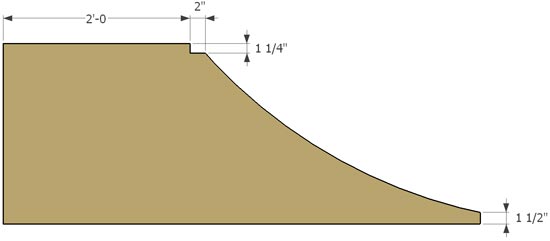
CUT THE TRANSITION
Very carefully cut on the lines you drew for the transition. The top layer for the deck comes out of this 3/4" ply also, so try not to get too crazy with the jig saw.
Once cut, you can use this transition as your template to trace onto the plywood and cut out the other side.
FRAMING THE BOTTOM
Your done with the hardest part, now it's time to frame the quarter pipe. Start by attaching the bottom and top 2x4's as shown.
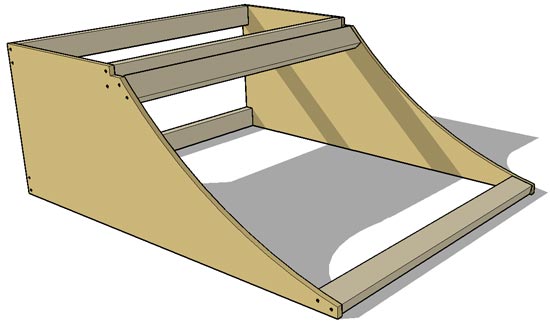
FRAMING THE CENTER
Take the remaining 2x4's and frame the deck and riding surface portion by placing the 2x4's 8" on center except where noted.
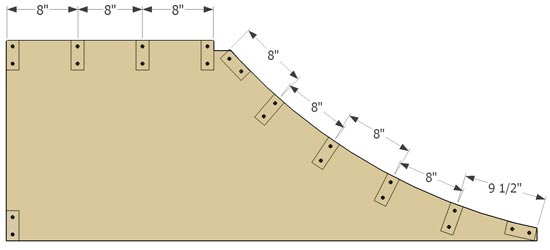
BUYING THE COPING
To find the steel, look up "steel yards", "structural steel" or "steel fabricators" and so on in the phone book.
The actual size of the steel pipe that you are looking for is 2 3/8" (60.33mm) outside diameter. With a wall thickness of 7/32". This pipe is known by steel shops as...
- 2" OD, Schedule 80, black steel pipe
Some steel shops are picky about what it's called so use the above name if they seem confused.
You can also use schedule 40 steel pipe (5/32" wall) as it is cheaper and lighter, but it may become dented. Schedule 80 pipe on the other hand will not dent under normal skateboarding use.
Do not use PVC pipe (plastic) or electrical conduit, if you want it to last.
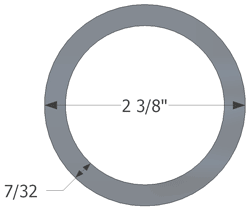
CUTTING AND DRILLING THE COPING
Cut your steel pipe to 4' long with a steel cutting blade (carbide blade) and miter saw or circular saw.
To attach the pipe to the ramp using screws, start by marking the pipe about 3" in from the ends and then about every two feet in between. Now drill a 3/8" on the outside and a 3/16" hole on the inside of the pipe.
This will allow you to feed a screw through the pipe and attach it to the ramp while still having access to screw it down. This is a common method and works well. However there are other ways of attaching the coping, such as bolts. This will be discussed in detail elsewhere on the site.
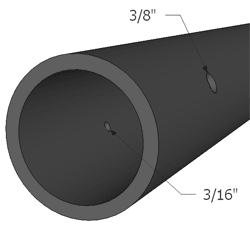
ATTACH THE COPING
Once drilled, place the coping in the notch you cut out earlier. By feeding a screw through the outside 3/8" hole, place it into the 3/16" inner hole. This can be tricky but with a little patience you'll get it.
With a drill or screwdriver, screw it down and move on to the next pre drilled hole. You should have a screw on each end and one in the middle.
By the way, don't worry about the holes interfering with your skating. You'll never feel them, guaranteed (unless they are larger than 3/8").

COVERING THE RAMP
Take the remaining 3/4" plywood, cut out a piece 4' by 2' and screw it to the top of the ramp putting screws about a foot apart in each 2x4.
Also at this time get your 3/8" plywood and cut out a piece 3'-10 by 4'-0 leaving you with 4'-0 by 4'-2 for the next layer. Start at the top and place the screws about a foot apart working your way down the ramp. Make sure you hit the studs when your attaching it.

NEXT LAYER AND MASONITE
Take the remaning 4'-0 by 4'-2 piece of 3/8" and lay it over the previous layer. Make sure you screw into the 2x4's. On a ramp this size you can lay a 2x4 across and mark where the studs are located or use a chalk line.
With both of the 3/8" sheets fully screwed down, cut a piece of masonite 3'-6 by 4'-0 and attach it the same way you did the last two layers. Only this time you will want to countersink your screws a little bit using a countersink bit or a 3/8" drill bit. This allows the surface to be as smooth as possible and keeps your body from being ripped to shreds during a fall.
With the masonite on you will be able to check the coping placement. I prefer the coping to stick out 3/8". To change it, you can remove the coping and place wood shims where it meets the 2x4's.

ATTACHING THE THRESHOLD
If constructed properly, you should have about 1'-0 between the masonite and the ground. This is where you place the 4' x 1', 3/16" thick sheet metal or 1/4" plastic.
Drill a 3/16" hole about 2 inches in from each end on both sides and one in the middle. After the holes are drilled, countersink each by using the 3/8" drill bit to drill down just enough so the screw heads are flush.
The steel threshold is also availabe at steel fabrication shops. You may be able to find the steel at home improvement stores too. They don't have the best selection, but it might be enough to get you by.

SKATE IT
Once again, that's it. Break out the radio and learn those pivot to fakies you've always wanted to do (then share the knowledge with me, I suck at that trick).
Update: I just built one of these but about 6" taller. I'll probably share the plans for that one as well. I still can't do pivot to fakies on it, honestly don't think I'll ever learn that. But my friend learned how to do rock to fakie's on that two and a half foot tall quarter we built and I'm very proud of her.